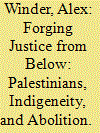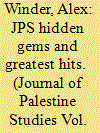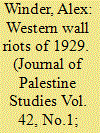|
|
|
Sort Order |
|
|
|
Items / Page
|
|
|
|
|
|
|
| Srl | Item |
| 1 |
ID:
180232


|
|
|
|
|
| Summary/Abstract |
This essay examines the practices and institutions of “rebel justice” that emerged during two of the most effective and sustained anti-colonial uprisings of the twentieth century, the Great Revolt and the First Intifada. It addresses these uprisings “from below” to illuminate their social foundations and the kinds of futures they imagined. For Palestinians, communal justice (sulh, ‘urf, and the like) have been prevalent forms of dispute resolution and justice-seeking. Rather than being written in a criminal code, the foundation of justice was based on shared notions of honor, redemption, and a social order that balanced hierarchical impulses with egalitarian ones. The essay also addresses Palestine’s place within abolitionist discussions currently under way in the United States, building upon the notable connections and parallels between the two geographies, from joint trainings undertaken by U.S. and Israeli forces to recent manifestations and longer traditions of Black-Palestinian solidarity.
|
|
|
|
|
|
|
|
|
|
|
|
|
|
|
|
| 2 |
ID:
178336


|
|
|
|
|
| Summary/Abstract |
Perusing JPS’s fifty years of documenting Palestinian history, this essay reminds us that history is both “what happened” as well as “the narration of what happened.” Anchoring his selection in that perspective, Alex Winder identifies Charles Anderson’s “State Formation from Below and the Great Revolt in Palestine” (2017) as a JPS “hidden gem,” and Tarif Khalidi’s “Palestinian Historiography: 1900–1948” (1981) as a “greatest hit.” Relying on primary sources by participants in the rebellion and highlighting the history of the revolt, Anderson shifts the focus of traditional accounts of the revolt from the mostly ineffective role of Palestinian notables and elites to the successes of the rebels. In a similar vein, Khalidi’s article paints a picture of a rich and vibrant Palestinian intellectual life in the first half of the twentieth century that reverses the conventional view of the colonized as reactive and of the colonizer as the primary agent of history.
|
|
|
|
|
|
|
|
|
|
|
|
|
|
|
|
| 3 |
ID:
118543


|
|
|
|
|
| Publication |
2012.
|
| Summary/Abstract |
This article analyzes the outbreak of the deadly 1929 riots in Palestine. Focusing on Jerusalem, Safad, and Hebron, the cities most significantly affected by the events, the article sees the violence as attempts to reinforce, redefine, or reestablish communal boundaries. It argues that patterns of violence in each city can help us understand how these boundaries had been established and evolved in the past, as well as the ways in which new forces, in particular the economic, political, and social influence of the Zionist movement and the rise of nationalist politics among the Palestinian Arabs, had eroded older boundaries.
|
|
|
|
|
|
|
|
|
|
|
|
|
|
|
|
|
|
|
|
|